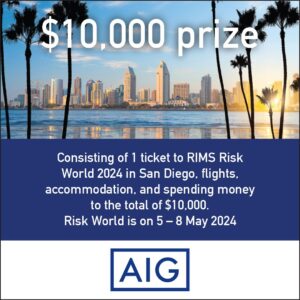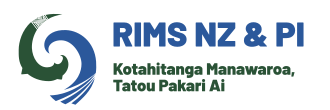
This person offered original insights from a unique perspective as both a risk professional and someone with matauranga Māori and tikanga knowledge.
The person gave interesting and real life examples where the consideration both western and Te Ao Māori views from a risk management approach would have mitigated a number of adverse consequences.
The piece was well balanced with useful information to address objections and other considerations. The overarching theme was addressing the key question “are our current risk management tools enough to ensure resilience and adaptability in a rapidly changing world” fitting the brief well of this years conference theme of “Embracing the Unknown”.
The key takeaway was the importance of the Māori world view “offering a powerful lens for risk management through its inherent systems thinking, rooted in deep understanding of the inter-connectivity of all things, including people, environment and lived experience and ancestral knowledge. It recognised both the individual and the collective, the visible and invisible, and the present and future being intricately woven.”
On behalf of AIG it’s a privilege to announce the winning entry: Embracing the Unknown: can indigenous wisdom bridge the gap in modern risk management by Laura Toulmin
What an amazing prize – We wish you an amazing trip – we want to hear all about it!!!!
Embracing the Unknown: Can Indigenous Wisdom Bridge the Gap in Modern Risk Management?
Ever since people started walking this earth, humans have been faced with uncertainty, navigating a world where unexpected twists and turns lurk around every corner. But as we grapple with the unprecedented compounding challenges of climate change, social inequality, and an interconnected world spinning faster, the question arises: are our current risk management tools enough to ensure resilience and adaptability in a rapidly changing world?
Current Western risk management approaches are effective in developing meticulous models and data-driven analyses to offer valuable insights; however, often fall short in capturing the complex interplay of human, environmental, and cultural factors that shape our future. In this turbulent landscape, a potential source of resilience and adaptability is overlooked– the wisdom embedded within indigenous worldviews.
There is opportunity for Risk Professionals and Business Managers in Aotearoa New Zealand for example, to look down the lens of both Te Ao Māori (Māori worldview) and Western risk management approaches to see a new ‘binocular’ view of risk management that embraces the strengths of each. Drawing on the inherent interconnections and a more collaborative approach that is fundamental to Te Ao Māori but that Western risk management often fails to deliver.
This perspective draws on my experiences as a risk management professional and student of tikanga and mātauranga Māori to explore the limitations of Western risk management approaches and offers an opportunity for business to reframe current thinking and embrace Te Ao Māori to ensure resilience and adaptability.
‘Western’ Risk Management Lens
Western risk management approaches typically take a data-driven, analytical stance. They rely on quantitative methodologies, statistical analysis, and scenario planning to identify, assess, and mitigate potential threats. Technological advancements play a prominent role, with sophisticated software and monitoring systems utilised to predict and manage risk in real-time. The goal is to control risk through proactive measures like policies, safety protocols, and insurance.
The approach emphasises individual accountability assigning responsibility for risk management to specific roles and departments within an organisation and has a strong focus on short-term outcomes, aiming to minimise immediate losses and ensure operational efficiency.
Western risk management approaches offer valuable tools and frameworks which can be effective for identifying and assessing immediate threats, and in contributing to increased efficiency, safety, and financial stability. However, these approaches come with limitations:
- Emphasis on quantification and control: Can overlook boarder systemic issues, the complex web of interconnectedness within systems and qualitative factors like cultural nuances, unforeseen consequences, and long-term ecological impacts. Consequently, leading to a narrow focus on immediate risks, neglecting the potential long-term consequences of risk decisions.
- Focus on individual accountability: Can foster a culture of blame, siloed thinking, and hinder collaboration, making it harder to address systemic issues and hidden vulnerabilities.
- Emphasis on technological solutions: Can create overreliance on external tools, neglecting traditional knowledge and local expertise that may offer vital insights.
If these limitations remain unaddressed, they can lead to blind spots and unintended consequences, making organisations vulnerable to unforeseen risks.
Consider the 2016 Campylobacter outbreak in Havelock North, New Zealand caused by contamination in the water supply. This event is an example of both ineffective risk management and a slow, inadequate response. It was not an unpredictable event. Despite having high E.coli readings and heavy weather events in recent years prior to the outbreak, the risk management approach prioritised reactive treatments and immediate compliance with drinking water standards over long-term prevention measures. There was a failure to recognise the root causes of unsustainable land use practices and outdated water infrastructure, as well as the interconnectedness of land use, water quality, and community health. This led to lax oversight of faulty bores and a vulnerable aquifer and failure identifying potential contamination sources from nearby livestock.
When the first cases of illness surfaced, the response was inadequate, with a siloed approach, limited communication between water authorities and health departments, an initial downplaying of the situation, delayed public notifications, and inadequate resources for distributing bottled water. Initially, authorities downplayed the severity of the situation, attributing it to a seasonal bug. Delayed diagnoses and conflicting information fuelled public panic and distrust. Even after the source was identified, the response remained reactive rather than proactive. The reliance on reactive measures like boil-water notices revealed a lack of proactive steps to protect water sources and mitigate potential risks. Communication breakdowns and slow action to provide clean water and sanitation amplified the suffering and hampered recovery efforts. The crisis exposed a glaring gap between risk preparedness and actual response, leaving the community reeling in the aftermath.
Had a Te Ao Māori approach been incorporated, the story might have been different. The foundational Māori concept of interconnectedness would have placed emphasis on understanding the relationships between water sources, land use, and the overall health of the ecosystem. Risk management wouldn’t just be about technical solutions, but also about kaitiakitanga (guardianship), and long-term responsibility for the wellbeing of the land and its people. A whānau (family)-centred approach and community engagement would have ensured clear communication and collaboration action in crisis response, prioritising both public health and social solidarity. By acknowledging the complex web of interdependencies, a Te Ao Māori lens could have helped avert the crisis and ensured a more holistic and resilient response, leaving Havelock North not just with cleaner water, but also with a stronger, more interconnected community.
Te Ao Māori Lens
Te Ao Māori, the Māori worldview, offers a powerful lens for risk management through its inherent systems thinking. Rooted in a deep understanding of the interconnectedness of all things, including people, environment, and ancestral knowledge. It recognises both the individual and the collective, the visible and invisible, and the present and the future, as being intricately woven. This holistic perspective translates into risk management focused not just on isolated incidents, but on understanding the complex web of relationships and dependencies that influence them. It encourages collaborative approaches, prioritising whanaungatanga (wellbeing) of not just the organisation, but the wider community and environment it operates within. By embracing kaitiakitanga, Te Ao Māori encourages long-term planning and proactive risk mitigation, recognising that today’s actions have consequences for generations to come. This intergenerational equity fosters resilient systems that can adapt and thrive in the face of uncertainty, mirroring the enduring strength and wisdom of Te Ao Māori itself.
Through a Te Ao Māori lens, risk is not simply a technical challenge to be mitigated, but an imbalance within the wider web of life, requiring holistic solutions that consider the well-being of both people and the natural world. Take rāhui as an example: a temporary restriction placed on an area or resource to enable time and space for the natural and spiritual environments to restore balance and promote resilience, often in response to environmental degradation, depletion, or cultural concerns. This pause serves not only as a reactive measure to protect resources during times of scarcity or environmental threat, but also as a proactive strategy for long-term sustainability and community well-being. It’s not simply a prohibition, but an act of deep respect for the interconnectedness of the natural world and human activity. Moreover, it fosters community engagement and knowledge sharing, empowering local voices to be active participants in managing their own well-being and that of their environment.
Through rāhui, communities acknowledge their responsibility as kaitiakitanga, guardians of the land, ensuring the well-being of both present and future generations. By weaving together environmental protection, cultural renewal, and social cohesion, rāhui exemplifies the holistic and sustainable risk management approach that is deeply embedded within Māori traditions.
A Binocular View
The holistic Te Ao Māori approach to risk management contrasts with Western strategies that often focus on immediate remediation or technical solutions, neglecting social and cultural dimensions. By learning from and integrating Te Ao Māori wisdom into risk management practices, organisations can cultivate more responsible and resilient relationships with the environment and the communities they operate within, while gaining a deeper appreciation for both immediate and long-term risks. Additionally, fostering collaborative decision-making informed by traditional knowledge and values can lead to more sustainable and equitable solutions. In a practical sense, this would likely involve:
- Scenario planning: Combining quantitative predictions with qualitative scenario building informed by Te Ao Māori perspectives on environmental and social interdependencies
- Impact assessment: Expand beyond economic costs to consider the broader social, cultural and environmental ripple effects of our decisions
- Decision-making: Incorporating diverse voices and perspectives, including indigenous knowledge holders and future generations into risk assessment and decision-making processes
- Risk mitigation: Exploring nature-based solutions and traditional knowledge alongside technological advancements for adaptive risk management.
It’s time to move beyond the limitations of Western risk management and embrace Te Ao Māori wisdom, enabling businesses to move beyond short-term profit maximisation and embrace a more responsible, interconnected, and sustainable future. Weaving together Western approaches with traditional knowledge, cultural sensitivity, and holistic thinking, we can unleash a future where risk management is not just about mitigating threats, but about nurturing resilient communities and respecting the interconnectedness of life. —
Laura Toulmin Risk and Sustainability Manager
This article is my own perspective, it should not be interpreted to be representative of the diverse perspectives of Māori in Aotearoa, or of individual iwi.
